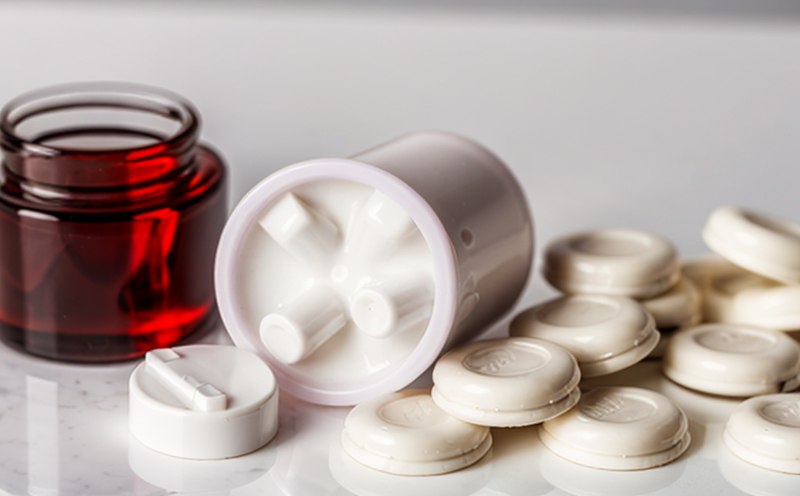USP Microbial Limit Testing of Capsules
The USP Microbial Limit Test (MLT) is a critical procedure within pharmaceutical quality assurance to ensure that oral solid dosage forms, such as capsules, are free from undesirable microorganisms and other pathogens. This test is particularly important for products intended for ingestion by humans or animals where contamination could pose significant health risks.
The USP MLT aims to determine the presence of certain specified microorganisms in a sample, including Escherichia coli, Pseudomonas aeruginosa, and yeasts and molds. Compliance with this test is mandatory for any pharmaceutical product that falls under the jurisdiction of the United States Pharmacopeia (USP). The primary purpose is to safeguard public health by ensuring that these products meet stringent quality standards.
The testing process involves several steps, including sample collection, preparation, and incubation, followed by microbial identification. During this phase, all viable microorganisms are counted using a series of dilutions and plating techniques. The results are then compared against the USP guidelines to determine whether the product meets acceptable limits.
Understanding the methodology behind MLT is crucial for those involved in pharmaceutical manufacturing and quality assurance. Compliance with these tests not only ensures adherence to regulatory requirements but also enhances consumer trust and safety.
- Increase in Consumer Confidence: Ensures products meet strict health and safety standards.
- Legal Compliance: Mandated by the USP, ensuring full compliance with pharmaceutical regulations.
- Product Safety: Minimizes the risk of contamination that could lead to adverse effects or recalls.
- Risk Management: Identifies potential issues early in the production process, allowing for corrective actions.
The importance of this test cannot be overstated. By adhering to USP MLT, pharmaceutical companies can ensure their products are safe and reliable, thereby protecting public health and maintaining brand integrity.
Scope and Methodology
The scope of the USP Microbial Limit Test encompasses a range of oral solid dosage forms, including capsules. The methodology involves several critical steps to ensure accurate results:
Sample Collection: Samples are collected from various batches or production runs using sterile techniques to avoid contamination.
Preparation: Prepared samples undergo dilution processes followed by inoculation into appropriate media suitable for the growth of specified microorganisms.
Inoculation and Incubation: The inoculated media are incubated under controlled conditions, allowing for the detection and quantification of viable microorganisms.
Identification and Counting: Once incubated, the samples undergo identification to confirm the presence or absence of specified organisms. Counts are then performed using standard microbiological techniques.
The results from these steps are compared against USP guidelines to determine compliance with microbial limits for oral solid dosage forms such as capsules.
This detailed process ensures that all potential contaminants are identified and quantified, providing a comprehensive assessment of product safety.
Benefits
- Enhanced Product Safety: Ensures products meet strict health and safety standards.
- Regulatory Compliance: Mandated by the USP, ensuring full compliance with pharmaceutical regulations.
- Consumer Trust: Builds confidence in the quality of the product among consumers.
- Risk Mitigation: Identifies potential issues early, allowing for timely corrective actions.
- Quality Assurance: Provides a robust framework for continuous improvement and quality control.
- Brand Protection: Maintains brand integrity by ensuring product safety and reliability.
The benefits of USP Microbial Limit Testing extend beyond regulatory compliance to encompass broader health and safety considerations. By adhering to these stringent tests, pharmaceutical companies can ensure their products meet the highest standards, thereby protecting public health and maintaining consumer trust.
Why Choose This Test
The USP Microbial Limit Test is essential for any company involved in the production of oral solid dosage forms like capsules. Here are several reasons why this test should be a priority:
Regulatory Mandate: The USP mandates compliance with this test, making it a legal requirement.
Risk Reduction: By identifying and quantifying potential contaminants early in the production process, companies can minimize risks associated with product contamination.
Consumer Trust: Ensuring that products meet stringent quality standards enhances consumer confidence, which is crucial for brand reputation and market success.
Risk Management: This test allows for proactive management of potential health hazards by identifying issues before they escalate into full-blown crises.
Quality Assurance: The USP MLT provides a structured approach to quality assurance, ensuring that all products meet the highest standards.
Brand Integrity: By adhering to this test, companies can protect their brand integrity and maintain public trust in the safety of their products.
In conclusion, the USP Microbial Limit Test is not just a regulatory requirement but a vital tool for ensuring product safety, compliance, and consumer trust. Choosing this test ensures that your products meet the highest standards of quality and safety.





